tow Citroen GRAND C4 PICASSO RHD 2017 2.G Owner's Guide
[x] Cancel search | Manufacturer: CITROEN, Model Year: 2017, Model line: GRAND C4 PICASSO RHD, Model: Citroen GRAND C4 PICASSO RHD 2017 2.GPages: 523, PDF Size: 11.96 MB
Page 186 of 523
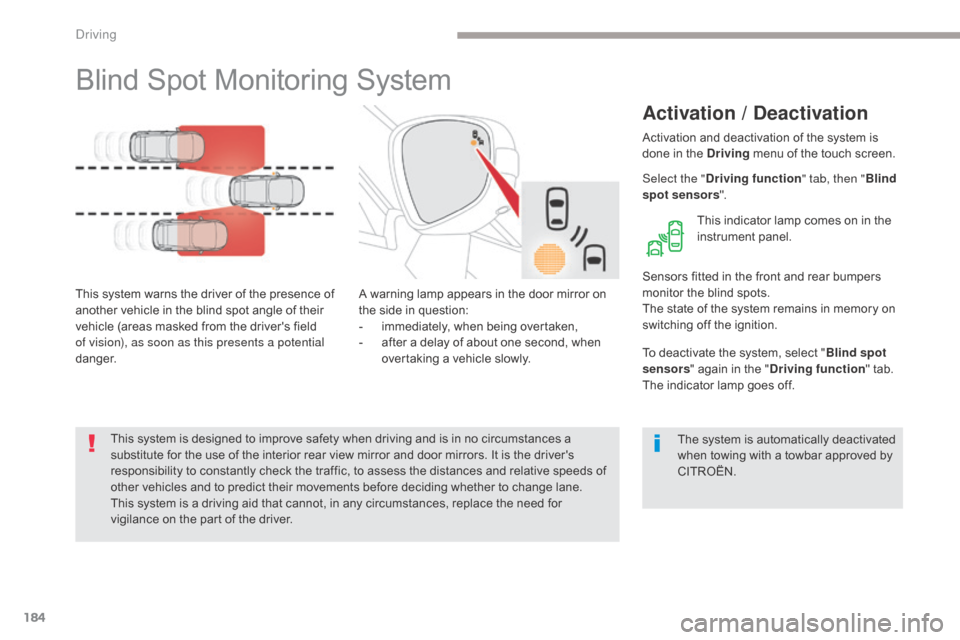
184
Blind Spot Monitoring System
Activation / Deactivation
A warning lamp appears in the door mirror on
the side in question:
-
i
mmediately, when being overtaken,
-
a
fter a delay of about one second, when
overtaking a vehicle slowly.
This system warns the driver of the presence of
another vehicle in the blind spot angle of their
vehicle (areas masked from the driver's field
of vision), as soon as this presents a potential
danger. Sensors fitted in the front and rear bumpers
monitor the blind spots.
The state of the system remains in memory on
switching off the ignition.
This system is designed to improve safety when driving and is in no circumstances a
substitute for the use of the interior rear view mirror and door mirrors. It is the driver's
responsibility to constantly check the traffic, to assess the distances and relative speeds of
other vehicles and to predict their movements before deciding whether to change lane.
This system is a driving aid that cannot, in any circumstances, replace the need for
vigilance on the part of the driver. Activation and deactivation of the system is
done in the Driving
menu of the touch screen.
Select the " Driving function " tab, then "Blind
spot sensors ".
This indicator lamp comes on in the
instrument panel.
To deactivate the system, select " Blind spot
sensors " again in the " Driving function " tab.
The indicator lamp goes off.
The system is automatically deactivated
when towing with a towbar approved by
CITROËN.
Driving
Page 192 of 523

190
Front parking sensors
The sound emitted by the speaker (front
or rear) indicates whether the obstacle
is in front or behind.The system will be deactivated
automatically if a trailer is being
towed or a bicycle carrier is fitted on
a towbar (vehicle fitted with a towbar
installed in line with the manufacturer's
recommendations).In bad weather or in winter, ensure
that the sensors are not covered with
mud, ice or snow. When reverse gear is
engaged, an audible signal (long beep)
indicates that the sensors may be dirty.
Certain sound sources (motorcycle,
lorry, pneumatic drill, etc.) may trigger
the audible signals of the parking
sensor system.
As an addition to the rear parking sensors, the
front parking sensors are triggered when an
obstacle is detected in front and the speed of
the vehicle remains below 6 mph (10 km/h).
The front parking sensors are interrupted if
the vehicle stops for more than three seconds
in for ward gear, if no further obstacles are
detected or when the speed of the vehicle
exceeds 6 mph (10 km/h).
The parking sensors can be deactivated in the
touch screen.
F
I
n the Driving
menu, select the " Driving
function " tab, then " Parking sensors ".
Operating fault
In the event of a malfunction of
the system, when reverse gear is
engaged, this warning lamp flashes
for a few moments then stays on
continuously.
This indicator comes on in the
instrument panel.
A new selection reactivates the function.
High pressure jet wash
When washing your vehicle, do not
direct the lance within 30 cm of the
sensors.
The parking sensors are deactivated
while the Park Assist system is
measuring a space.
For more information on Park Assist
,
refer to the corresponding section.
Deactivation / Activation of
the front and rear parking
sensors
A message appears, accompanied by an
audible signal.
Contact a CITROËN dealer or a qualified
workshop.
Driving
Page 201 of 523
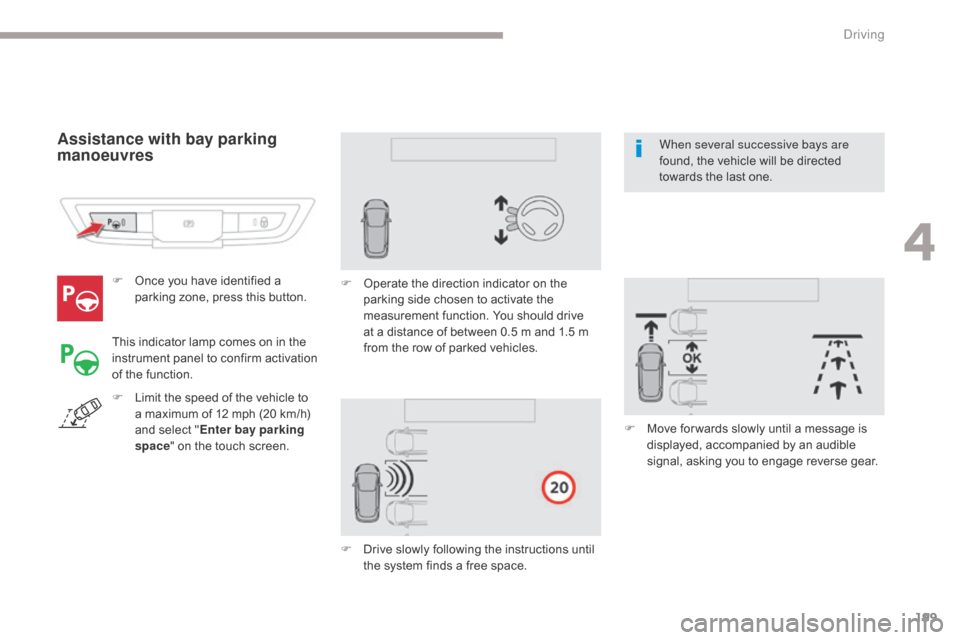
199
F Once you have identified a parking zone, press this button.
Assistance with bay parking
manoeuvres
This indicator lamp comes on in the
instrument panel to confirm activation
of the function. F
O
perate the direction indicator on the
parking side chosen to activate the
measurement function. You should drive
at a distance of between 0.5 m and 1.5 m
from the row of parked vehicles.
F
D
rive slowly following the instructions until
the system finds a free space. F
M
ove for wards slowly until a message is
displayed, accompanied by an audible
signal, asking you to engage reverse gear.
F
L
imit the speed of the vehicle to
a maximum of 12 mph (20 km/h)
and select " Enter bay parking
space " on the touch screen. When several successive bays are
found, the vehicle will be directed
towards the last one.
4
Driving
Page 203 of 523
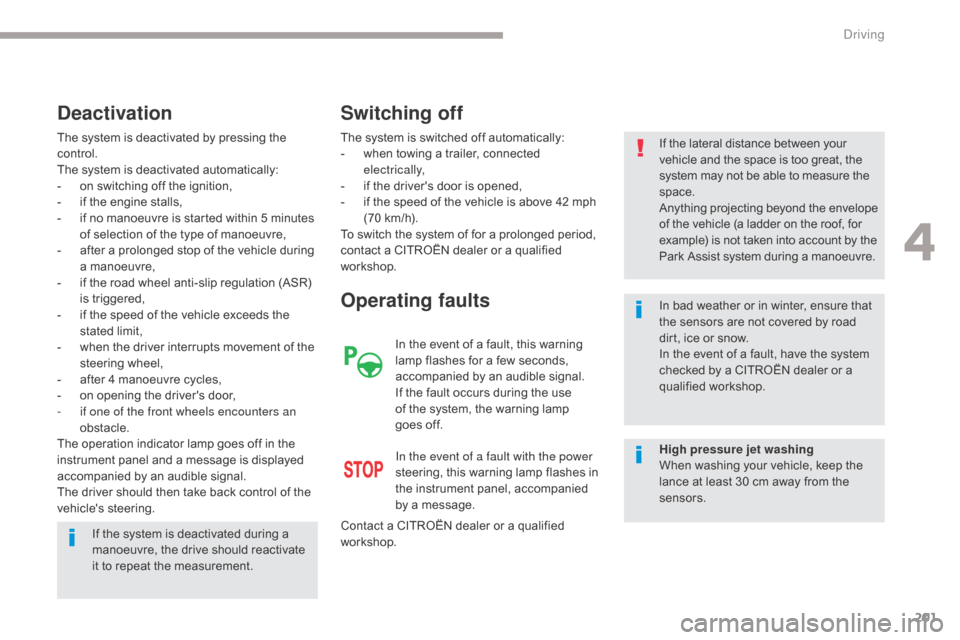
201
The system is deactivated by pressing the
control.
The system is deactivated automatically:
-
o
n switching off the ignition,
-
i
f the engine stalls,
-
i
f no manoeuvre is started within 5 minutes
of selection of the type of manoeuvre,
-
a
fter a prolonged stop of the vehicle during
a manoeuvre,
-
i
f the road wheel anti-slip regulation (ASR)
is triggered,
-
i
f the speed of the vehicle exceeds the
stated limit,
-
w
hen the driver interrupts movement of the
steering wheel,
-
a
fter 4 manoeuvre cycles,
-
o
n opening the driver's door,
-
i
f one of the front wheels encounters an
obstacle.
The operation indicator lamp goes off in the
instrument panel and a message is displayed
accompanied by an audible signal.
The driver should then take back control of the
vehicle's steering.
Deactivation
The system is switched off automatically:
- w hen towing a trailer, connected
electrically,
-
i
f the driver's door is opened,
-
i
f the speed of the vehicle is above 42 mph
(70 km/h).
To switch the system of for a prolonged period,
contact a CITROËN dealer or a qualified
workshop.
Operating faults
In the event of a fault with the power
steering, this warning lamp flashes in
the instrument panel, accompanied
by a message.
Contact a CITROËN dealer or a qualified
workshop.
Switching off
If the lateral distance between your
vehicle and the space is too great, the
system may not be able to measure the
space.
Anything projecting beyond the envelope
of the vehicle (a ladder on the roof, for
example) is not taken into account by the
Park Assist system during a manoeuvre.
In bad weather or in winter, ensure that
the sensors are not covered by road
dirt, ice or snow.
In the event of a fault, have the system
checked by a CITROËN dealer or a
qualified workshop.
If the system is deactivated during a
manoeuvre, the drive should reactivate
it to repeat the measurement. In the event of a fault, this warning
lamp flashes for a few seconds,
accompanied by an audible signal.
If the fault occurs during the use
of the system, the warning lamp
goes
off. High pressure jet washing
When washing your vehicle, keep the
lance at least 30 cm away from the
sensors.
4
Driving
Page 211 of 523
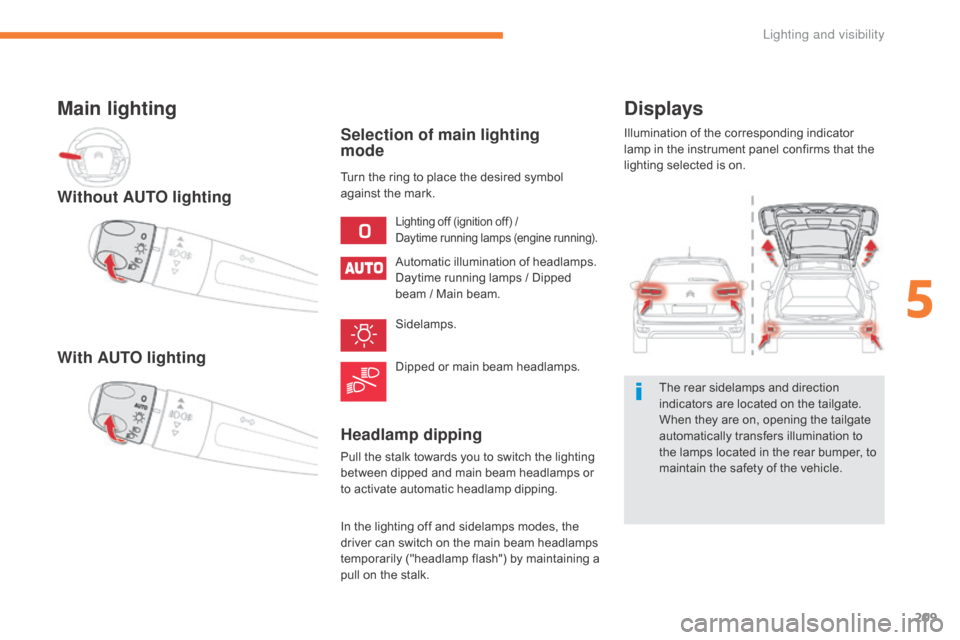
209
Displays
Illumination of the corresponding indicator
lamp in the instrument panel confirms that the
lighting selected is on.The rear sidelamps and direction
indicators are located on the tailgate.
When they are on, opening the tailgate
automatically transfers illumination to
the lamps located in the rear bumper, to
maintain the safety of the vehicle.
Main lighting
Lighting off (ignition off) /
Daytime running lamps (engine running).
Automatic illumination of headlamps.
Daytime running lamps / Dipped
beam / Main beam.
Sidelamps.
Dipped or main beam headlamps.
Turn the ring to place the desired symbol
against the mark.
Selection of main lighting
mode
Without AUTO lighting
With AUTO lighting
Headlamp dipping
Pull the stalk towards you to switch the lighting
between dipped and main beam headlamps or
to activate automatic headlamp dipping.
In the lighting off and sidelamps modes, the
driver can switch on the main beam headlamps
temporarily ("headlamp flash") by maintaining a
pull on the stalk.
5
Lighting and visibility
Page 222 of 523
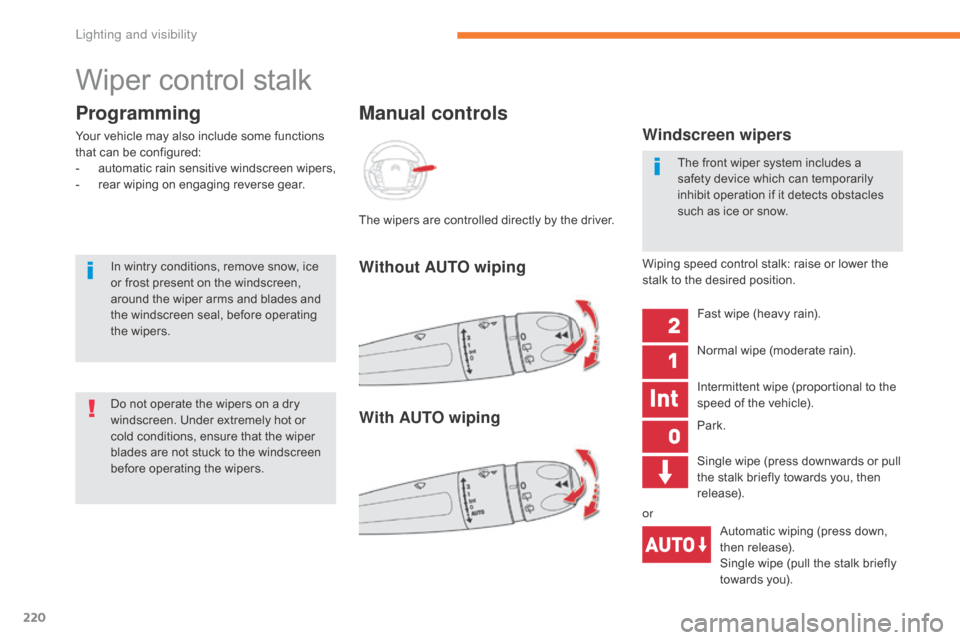
220
Wiper control stalk
Programming
Your vehicle may also include some functions
that can be configured:
-
a
utomatic rain sensitive windscreen wipers,
-
r
ear wiping on engaging reverse gear.
Manual controls
Windscreen wipers
Fast wipe (heavy rain).
Normal wipe (moderate rain).
Intermittent wipe (proportional to the
speed of the vehicle).
Park.
Automatic wiping (press down,
then release).
Single wipe (pull the stalk briefly
towards you).
The wipers are controlled directly by the driver.
Wiping speed control stalk: raise or lower the
stalk to the desired position.
Without AUTO wiping
With AUTO wiping
Single wipe (press downwards or pull
the stalk briefly towards you, then
release).
or
In wintry conditions, remove snow, ice
or frost present on the windscreen,
around the wiper arms and blades and
the windscreen seal, before operating
the wipers.
Do not operate the wipers on a dry
windscreen. Under extremely hot or
cold conditions, ensure that the wiper
blades are not stuck to the windscreen
before operating the wipers. The front wiper system includes a
safety device which can temporarily
inhibit operation if it detects obstacles
such as ice or snow.
Lighting and visibility
Page 224 of 523
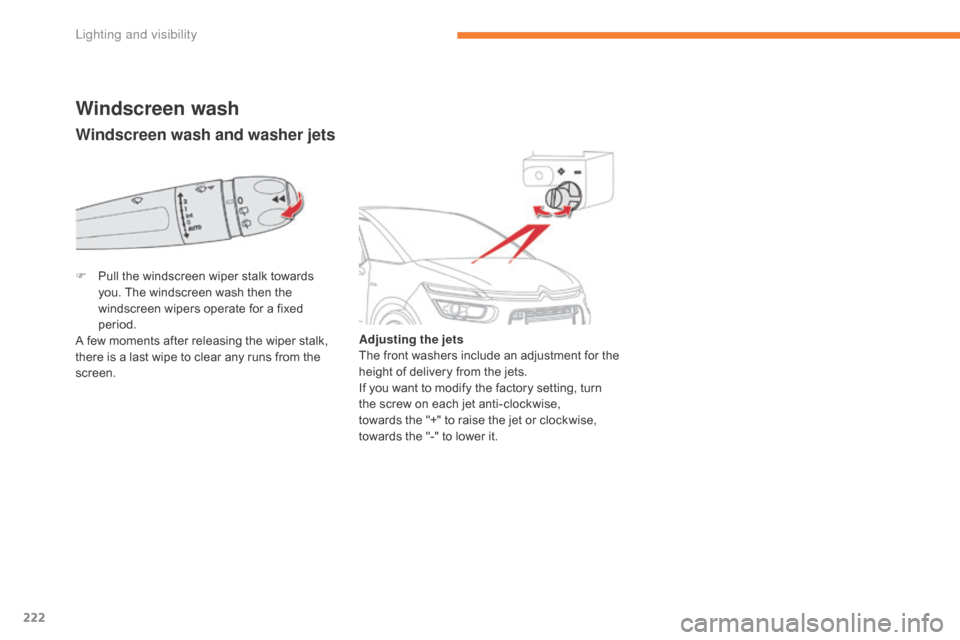
222
Windscreen wash and washer jets
Windscreen wash
Adjusting the jets
The front washers include an adjustment for the
height of delivery from the jets.
If you want to modify the factory setting, turn
the screw on each jet anti-clockwise,
towards the "+" to raise the jet or clockwise,
towards the "-" to lower it.
F
P
ull the windscreen wiper stalk towards
you. The windscreen wash then the
windscreen wipers operate for a fixed
period.
A few moments after releasing the wiper stalk,
there is a last wipe to clear any runs from the
screen.
Lighting and visibility
Page 229 of 523
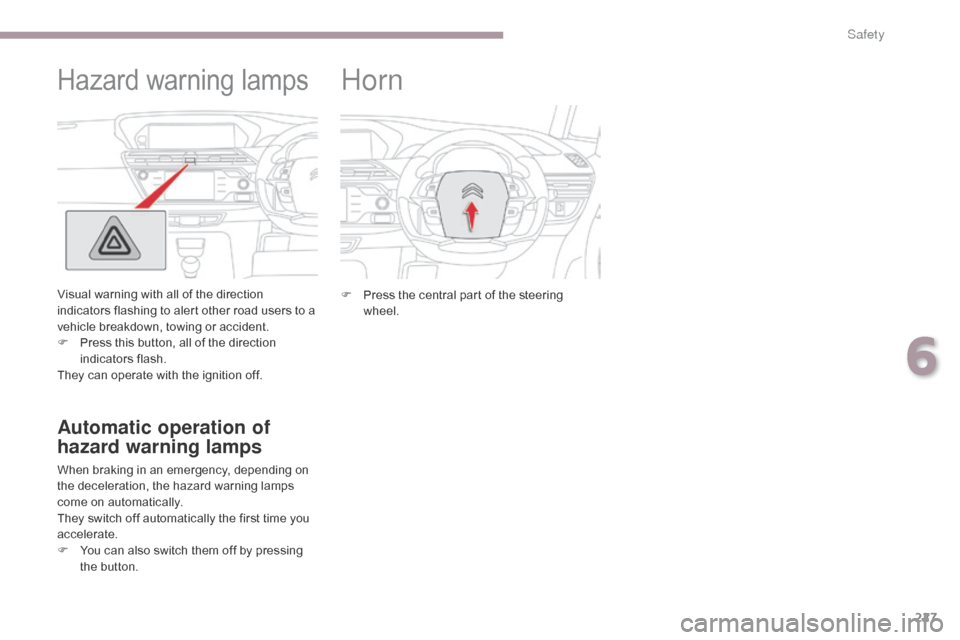
227
Hazard warning lamps
Visual warning with all of the direction
indicators flashing to alert other road users to a
vehicle breakdown, towing or accident.
F
P
ress this button, all of the direction
indicators flash.
They can operate with the ignition off.
Automatic operation of
hazard warning lamps
When braking in an emergency, depending on
the deceleration, the hazard warning lamps
come on automatically.
They switch off automatically the first time you
accelerate.
F
Y
ou can also switch them off by pressing
the button.
Horn
F Press the central part of the steering wheel.
6
Safety
Page 232 of 523

230
Electronic stability control (ESC) incorporating
the following systems:
-
a
nti-lock braking system (ABS) and
electronic brake force distribution (EBFD),
-
e
mergency braking assistance (EBA),
-
w
heel anti-slip regulation (ASR) or traction
control,
-
d
ynamic stability control (DSC).
Electronic stability control (ESC)
Definitions
Anti-lock braking system (ABS)
and electronic brake force
distribution (EBFD)
These systems improve the stability and
manoeuvrability of your vehicle when braking
and contribute towards improved control on
corners, in particular on poor or slippery road
surfaces.
The ABS prevents wheel lock in the event of
emergency braking.
The EBFD manages the braking pressure
wheel by wheel.
Emergency braking assistance
(EBA)
In an emergency, this system enables you to
reach the optimum braking pressure more
quickly and therefore reduce the stopping
distance.
It is triggered according to the speed at which
the brake pedal is pressed. This is felt by a
reduction in the resistance of the pedal and an
increase in the effectiveness of the braking.
Anti-slip regulation (ASR)
This system (also known as Traction Control)
optimises traction in order to limit wheel slip by
acting on the brakes of the driving wheels and
on the engine. It also improves the directional
stability of the vehicle on acceleration.
Dynamic stability control (DSC)
If there is a difference between the path
followed by the vehicle and that required by
the driver, the DSC monitors each wheel and
automatically acts on the brake of one or more
wheels and on the engine to return the vehicle
to the required path, within the limits of the laws
of physics.
Safety
Page 236 of 523

234
2nd row seat belts
The rear seats are each fitted with a seat belt,
three-point anchorages with inertia reel and
force limiter (except for the centre rear seat).Guide the belt as it reels in and place the
tongue on the magnet at the side anchorage
point.
2nd row outer seat belts
(stowing)
Safety